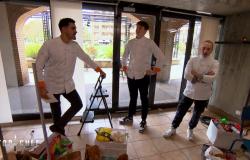If it all really began with a meeting between Keith and Mick on a platform at Darford station in the suburbs of London, it was a long road until the release of The Rolling Stones’ very first album.
April 17, 1964: release of The Rolling Stones’ first album
Dartford station on the morning of December 17, 1961. Keith stood on the platform that day, waiting for the train, a Chuck Berry record in his hand. Mick spots him, and they discuss their musical tastes. Jagger is also a fan of Chuck Berry and he hangs out with a group of passionate friends who meet every Saturday morning in a bar equipped with a jukebox to listen to rock and American rhythm’n’blues records. Mick suggested that Keith come see them and it was at this time that their friendship was born.
The two friends then begin to search the record store bins together, looking for records by Chuck Berry, Buddy Holly, Eddie Cochran, Jimmy Reed, BB King, Little Milton or Muddy Waters, which they cannot find in their usual store. . At the same time, Jagger also had numerous blues and rhythm’n’blues records delivered by mail, ordered directly from Chess Records, a Chicago label. And this enormous collection makes all collectors and blues fans, including Keith Richards, drool with envy.
From time to time, Mick and Keith drive to Manchester to see concerts by legendary artists, such as John Lee Hooker, Memphis Slim, Junior Wells, Buddy Guy and Hubert Sumlin. They are irresistibly drawn to the authenticity of the blues. They always agree when it comes to recognizing fake artists from real ones. And they try to find that in each of their own musical experiences, from the beginning.
During the summer of 1961, during a trip to the seaside with their parents in Devon, Keith, 17, and Mick, 18, played impromptu in a pub, the audience was amazed. angels. At the end of the year, they joined Dick Taylor, a friend of Keith from Sidcup who played bass, as well as Bob Beckwith on guitar and Allen Etherington on drums to form Little Boy Blue and the Blue Boys, with Mick Jagger as lead as Little Boy Blue. Among the first songs they
repeats include “That’ll Be The Day” and “Not Fade Away” by Buddy Holly, “Reelin’ and Rockin'” by Chuck Berry, “Bright Lights, Big City” by Jimmy Reed and “I Just Want To Make Love To You” by Muddy Waters.
Their first concerts as Little Boy Blue and the Blue Boys took place at the Ealing Jazz Club, London. Alexis Korner, the father of the London blues scene, also plays there every week with his group Blues Incorporated, in which there is the young Charlie Watts on drums and Ian Stewart on piano. It was also there that Mick and Keith met Brian Jones (whose full name was Lewis Brian Hopkins Jones) who at that time played slide guitar, under the pseudonym Elmo Lewis (in homage to the great guitarist of slide Elmore James, Delta blues legend). Although Richards always recognized Jones’ talent and great musical culture (Brian even became a sort of mentor for Keith, introducing him to Delta blues idols like Robert Johnson and Son House), he also saw the blonde guitarist from Cheltenham as someone cruel, manipulative and merciless, characteristics which will later have serious consequences.
Before the spring of 1962, Brian Jones and Ian Stewart decided to start a rhythm and blues group. They enlisted Jagger and Richards, Dick Taylor on bass and future Kinks drummer Mick Avory. They originally chose the name The Rollin’ Stones, after the title of a famous Muddy Waters song, “Rollin’ Stone”. They played their first concert as The Rolling Stones (with Tony Chapman on drums) at the Marquee Club in London on July 12, 1962. Their set included covers of Jimmy Reed’s “Bright Lights, Big City” and “Big Boss Man.” , “Back in the USA” by Chuck Berry, “Baby What’s Wong? ” by Willie Dixon, “Happy Home” and “Dust My Broom” by Elmore James, “I Ain’t Go You” by Billy Boy Arnold and a very rock’n roll version of the 1946 boogie-woogie hit “Down the Road Apiece” by Amos Milburn.
Over the next few months, they refined their wild interpretations of songs by Chuck Berry, Bo Diddley and Buddy Holly, infusing them with the raw Chicago blues sound of Jimmy Reed and Muddy Waters. Over time, Keith and Jones, his six-string partner, developed a complex complementary chemistry, in the spirit of certain formidable guitar duos like Muddy Waters and Jimmy Rogers, Howlin’ Wolf and Hubert Sumlin, or like the Myers brothers ( Louis and David), who played for Little Walter, a harmonica star. By apologizing during their concerts
of the music of Chicago blues musicians, the Rolling Stones opened a whole generation of young British people to these American sounds.
At the end of the summer of 1962, Mick, Keith and Brian moved into a run-down flat in the Fulham area. Accepting concerts in dance schools for meager fees (or even just beers), they barely manage to pay their rent and regularly steal from stores to get a little food. Before September they set up a weekly show at the Ealing Jazz Club, then in January they secured a Sunday afternoon residency at the Crawdaddy Club, a popular underground venue located at the Richmond Station Hotel, then run by a daring entrepreneur called by Giorgio Gomelsky, who unofficially joined the Stones, playing a managerial role.
In late January 1963, bassist Bill Wyman joined the group. Its powerful Vox amp gives The Rolling Stones the low-end punch they previously lacked. The Stones also improved by offering the services of drummer Charlie Watts, in high demand at the time, whom they had been trying to recruit for months. Watts had played with the group in late ’62, but refused to leave Blues Incorporated, which paid much better (and which brought together the talents of Jack Bruce on double bass, Alexis Korner on guitar, Dick Heckstall-Smith on saxophone, Keith Scott on piano, Cyril Davies on harmonica and Long John Baldry on vocals). Brian, Mick, Keith and the team could finally afford the fees requested by Watts, who officially joined the Stones on February 2, 1963, immediately bringing a solid rhythmic base to the group (his place in Blues Incorporated would be occupied by the future drummer by Cream, Ginger Baker.
Richards has often spoken in interviews about the character Watts brought to the band, describing his feel and ability to stretch the tempo as “the secret to the Stones sound.” As he says in a clip on the Ask Keith section of his website: “Without a good drummer, it’s awfully difficult to stay the course. Whereas a good drummer gives you the freedom to do what you want. We feel less stuck, that’s really the goal of the maneuver. And Charlie is one of the best drummers the world will ever know… so spontaneous and with a huge, beautiful personality, with subtle playing. It’s a constantly renewed happiness. He moves like an ace. Charlie Watts has always been the bed on which my music lies. »
Bassist Wyman explains the secret of the Stones’ distinctive rhythm this way: “It’s simple. Charlie hangs around, Keith gallops and I play well in the middle. “.
This fierce rhythmic struggle has wonderfully characterized the Stones’ music for decades.
It was during one of their weekly concerts at the Crawdaddy Club that this new formation of The Rolling Stones was noticed by Andrew Loog Oldham, former press officer of the Beatles. He took Gomelsky’s place as the group’s official manager in April 1963 and quickly negotiated a contract for the Stones with Decca Records, branding them “anti-Beatles”, playing with their bad boy image to pit them against the Fab Four, so charming with their mop-top cut and their suit jacket. Among the group’s first promotional campaigns, Oldham found this provocative slogan: “Would you let your daughter marry a Rolling Stone?” »
Their first single for Decca, a Chuck Berry cover called “Come On”, was released on June 7, 1963. The B-side included a Willie Dixon song, “I Want to Be Loved”, with Jones on harmonica. . On August 23, they played “Come On” as playback on the famous TV show Ready, Steady, Go, on the BBC. In the fall, the Stones went on tour for 5 weeks in the United Kingdom (from September 23 to November 3), opening for the Everly Brothers, Bo Diddley and Little Richard. Richards remembers: “It was incredible training. It felt like we were in Disneyland, or the amusement park of our dreams. »
On October 7, the Stones recorded their second single, a cover of the Lennon-McCartney song “I Wanna Be Your Man”. The other side features “Stoned,” an original song by Jagger and Richards. The single was released on November 1 and was a success in the United Kingdom. For their second UK tour, from February 7 to March 3, 1964, the Stones followed the Ronettes, a very popular American girl group. Keith had a brief romance with the group’s lead singer, Ronnie Bennett, who was working at the time with producer Phil Spector. Keith recalls: “We were 20 and we just fell in love. In fact, it’s mostly a matter of hormones. »
This is the Stones’ third single for Decca, a cover of Buddy Holly’s “Not Fade Away” on the back of which we find “Little By Little”, which will receive the first real success in the charts, climbing to number third place at the end of February 1964. Their first album, simply titled The Rolling Stones, was released by Decca on April 16, 1964, a few months after its recording in England. He offers supercharged versions of “I Just Want To Make Love To You” by Willie Dixon, “Route 66” by Bobby Troup, “Honest I Do” by Jimmy Reed, “Carol” by Chuck Berry, “I ‘my
King Bee” by Slim Harpo and “Walking the Dog” by Rufus Thomas, as well as Jagger and Richards’ first original track, “Tell Me (You’re Coming Back Again)”. The album was released on May 30, 1964 in the United States by London Records under the title England’s Newest Hit Makers. The rest is now history.
Belkacem Bahlouli
Discover in detail the career of The Rolling Stones in our special special issue, available via our online store.






